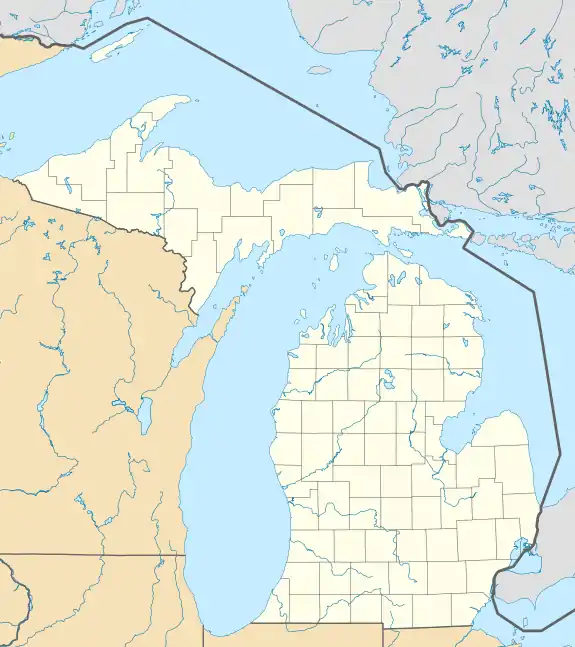Ford Valve Plant | |
 Ford Valve Plant. Note water wheel at extreme right. | |
  | |
Interactive map | |
| Location | 235 E. Main St., Northville, Michigan |
|---|---|
| Coordinates | 42°25′56″N 83°28′40″W / 42.43222°N 83.47778°W |
| Area | 4 acres (1.6 ha) |
| Built | 1936 |
| Architect | Albert Kahn |
| Architectural style | Art Deco |
| NRHP reference No. | 95000866[1] |
| Added to NRHP | August 01, 1995 |
The Ford Valve Plant is a factory building located at 235 East Main Street in Northville, Michigan. The plant was built as part of Henry Ford's vision of decentralizing manufacturing and integrating it into rural communities.[2] It was listed on the National Register of Historic Places in 1995.[1]
"Village Industries"
Northville's Valve Plant was the first of Henry Ford's "Village Industries" factories.[3] The Village industries were designed to bring the economic advantages of industrial jobs to rural communities through the establishment of decentralized, non-disruptive manufacturing plants.[2][3] In particular, Ford intended the Village Industries to stabilize the income of farmers who would otherwise have little winter income,[3][4] and he gave his workers leaves of absence to work their farms.[5]
Over the span of the 1920s and 1930s, Ford established over thirty more Village Industries factories, making everything from copper welding rods to lamp assemblies to wheels.[3] The plants tended to be small, employing around 100 workers. As in Northville, all of the factories were built on a riverbank (many at the former site of gristmills), and utilized hydroelectric power.[3][4]
History
Henry Ford purchased the property this building sits on in 1919.[2] The lot contained an old gristmill which was reconfigured into a valve manufacturing facility by moving machinery in from the Fordson and Highland Park plants.[6] Between 1919 and 1936, the plant manufactured over 180 million valves,[6] at a cost of less than half what it would be in the larger Highland Park plant.[5]
In 1936, Ford replaced the mill with an Albert Kahn-designed factory building.[2] The building reflects the then-current industrial architecture, as well as hints of Art Deco in the brickwork and entryway styling[7] but still incorporated a water wheel.[2]
The Village Industries program was discontinued in 1947, but the factory continued to produce valves.[2] The building was enlarged in 1956, and in 1969 over 150,000 valves were produced every day.[6] The plant continued operations until 1978, the longest lived of any former Village Industries factory,[2] and was later sold.[6] The building has been renovated into office space for use by design firms, such as HKS, Inc., an architecture firm, and Spider9, an environmental technology developer.[8]
References
- 1 2 "National Register Information System". National Register of Historic Places. National Park Service. March 13, 2009.
- 1 2 3 4 5 6 7 "Ford Valve Plant". Michigan State Housing Development Authority: Historic Sites Online. Archived from the original on June 6, 2011. Retrieved May 26, 2010.
- 1 2 3 4 5 "Village Industries Program". Ford Motor Co. Archived from the original on December 5, 2009. Retrieved May 26, 2010.
- 1 2 Lewis, David L. (1976), The Public Image of Henry Ford: An American Folk Hero and His Company, Wayne State University Press, pp. 162–163, ISBN 0-8143-1892-4
- 1 2 Henry Ford; Samuel Crowther (May 12, 1926). "Village Industries Prove Real Success; Solve Big Problem". The Milwaukee Sentinel. p. 4.
- 1 2 3 4 Louie, Barbara G. (2001), Northville Michigan, Arcadia Publishing, ISBN 0-7385-2359-3
- ↑ Farley, Ren. "Ford Valve Plant (Northville)". detroit1701.com.
{{cite web}}: Missing or empty|url=(help) - ↑ "HKS Detroit Office Relocates". dBusiness.com. Retrieved May 27, 2010.
Further reading
- Segal, Howard P. (2008), Recasting the Machine Age: Henry Ford's Village Industries, Univ of Massachusetts Press, ISBN 978-1-55849-642-2

